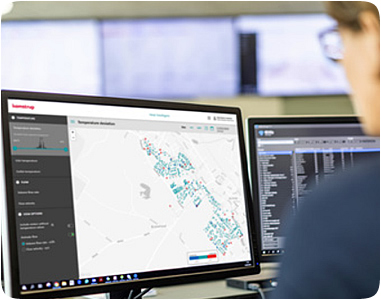 Investing in remote reading
and digitalisation is necessary
to ensure EED compliance
within district heating but also
opens up to new opportunities
for utilities, consumers as
well as the green transition.
Front runners have already
delivered great results from
combining their resolve with
the right solutions and a
trusted partner.
Investing in remote reading
and digitalisation is necessary
to ensure EED compliance
within district heating but also
opens up to new opportunities
for utilities, consumers as
well as the green transition.
Front runners have already
delivered great results from
combining their resolve with
the right solutions and a
trusted partner.
The Energy Efficiency Directive
(EED) was created with European
consumers in mind. It now requires
monthly readings of heat meters
and improved data availability for
end users to ensure energy billing
transparency and to empower them
to take responsibility for changing
their consumption behaviour.
For most utilities, EED compliance
involves a considerable investment.
However, remotely read meters and
frequent data also represent new
opportunities for value creation.
And once the meters are installed,
the additional expense to collect
daily or even hourly data is minimal
compared to the potential it unlocks.
Data-driven optimisation
First of all, frequent meter data
combined with the right tools and
analytics can help make district
heating the obvious choice wherever
feasible. This could include improving
customer closeness and motivating
further engagement. But having
the right data also enables utilities
to specifically guide customers on
lowering their consumption, monitor
the efficiency of their installations
or perhaps even offer to take over
installation operation entirely.
Secondly, smart meter data provide
the very basis for utilities to optimise
their core tasks of producing and
distributing district heating as well as
areas like asset management, design
and planning. Also, having frequent
data available is key to enabling
a cost-effective green transition
because that is a prerequisite for
lowering distribution temperatures
and integrating more renewable
energy sources, which impacts
costs substantially.
Studies show that cost reduction
gradients for renewables and
recycled heat, like geothermal,
solar or industrial excess heat, are a
factor 6-7 more cost-sensitive than
for energy sources that are burned,
like traditional waste and biomass.
In other words, with a heat supply
based on clean energy sources,
utilities generate much higher
savings for every degree they lower
their temperatures, and therefore
the green transition business case
depends on a utility’s ability to do so.
Unmistakable results
We are seeing a unique resolve
among many European district
heating utilities, and several of our
customers have already created
concrete and measurable results
based on frequent meter data and
increased digitalisation. They include
significantly lowering forward and
return temperatures, reducing heat
loss and removing hundreds of
bypasses – all while also saving
their customers money on their
energy bills.
For one customer, remotely read
meters, frequent data and targeted
analytics enabled them to lower
their forward temperature by 6-8°C,
cut pipeline losses by 14.5% and
reduce annual heat production by
2.5%. Translating new and large
amounts of data into actions was a
process, but being able to monitor
the exact temperature throughout the
distribution network allowed them to
continuously digitalise and optimise
their network and operations,
ultimately resulting in an ROI of only
4-5 years.
Same goal. Different journeys
EED or not, when it comes to
digitalisation of the district heating
value chain, one size will never
fit all. But it does represent both
new demands as well as new
opportunities that cannot be ignored.
At Kamstrup, we pride ourselves on
having the competences, solutions
and experience from mature district
heating markets to help and support
utilities in more immature markets
on their same journey. A journey
that goes beyond EED compliance
to utilising and benefitting from
the data-driven value creation it
also enables.